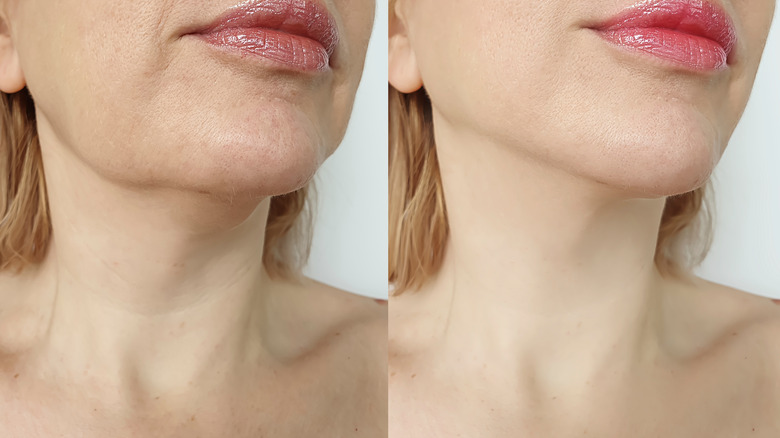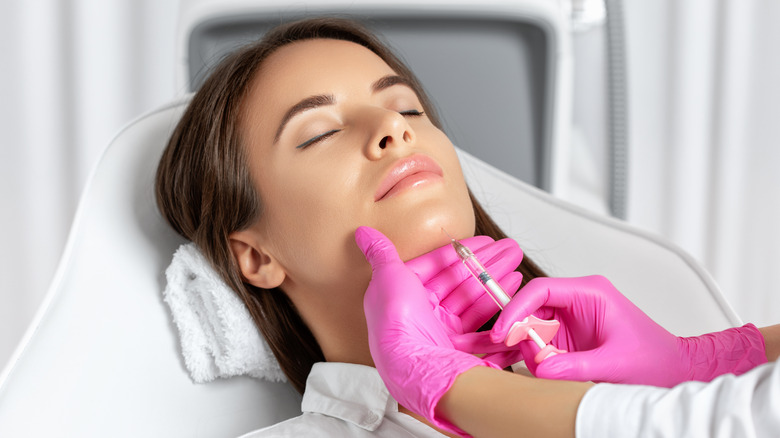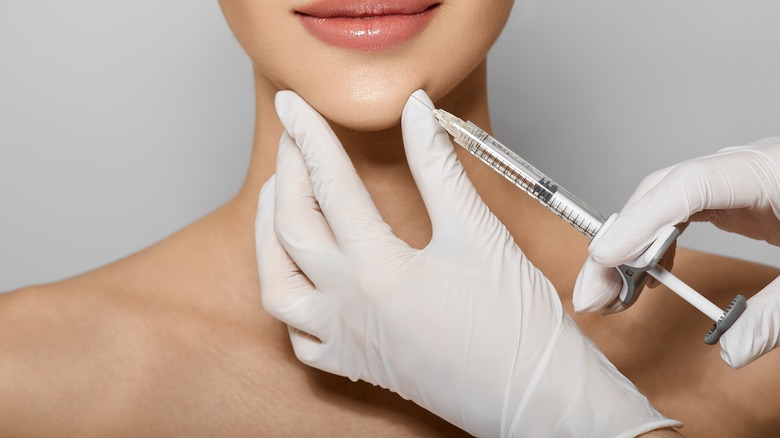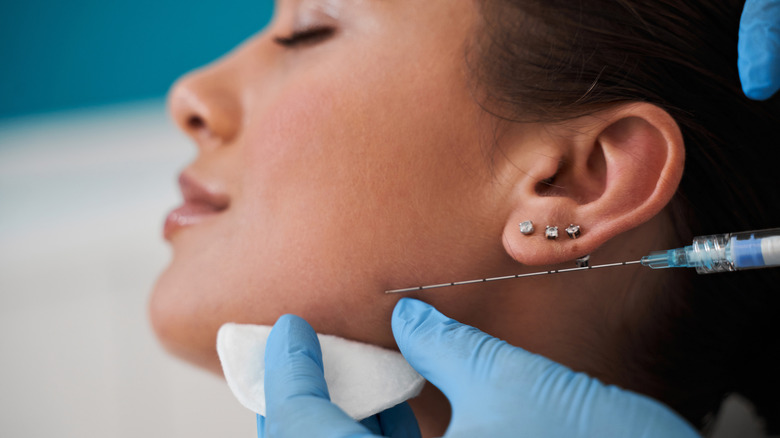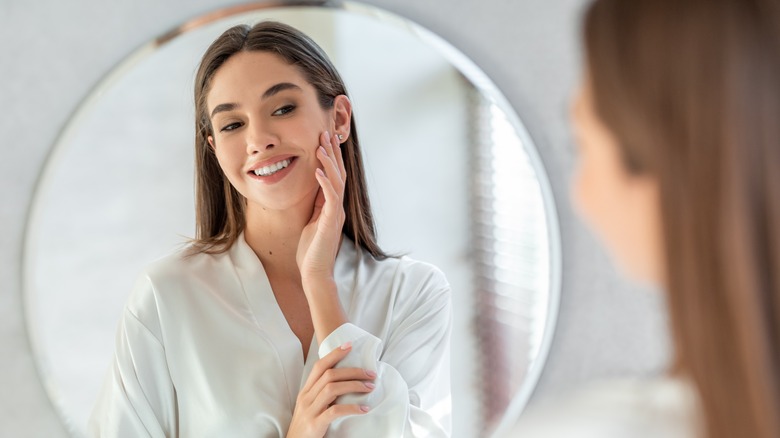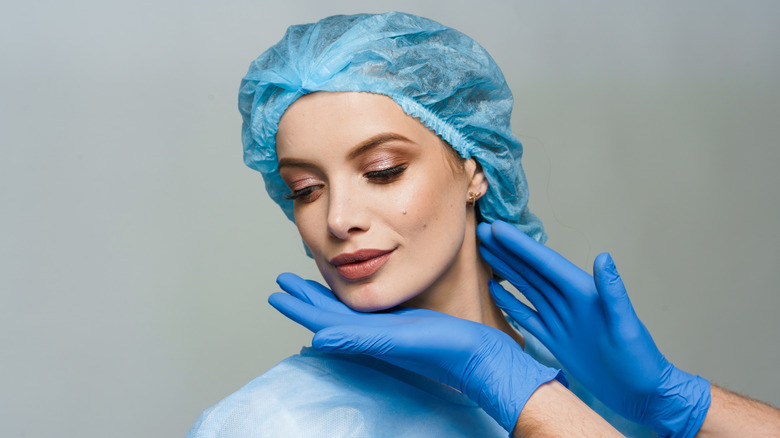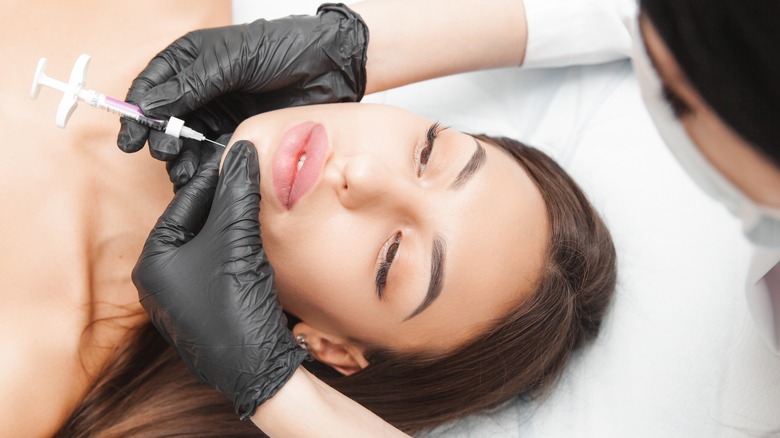Your Complete Guide To Understanding Chin Fillers
From a certain age, the skin begins to regenerate more slowly. Due to gravity and the skin's difficulty in renewing itself, overstretching or laxity is inevitable as the skin is unable to adhere to tissues. To prevent sagging, many procedures can now be performed with dermal fillers on specific parts of the face. Non-surgical procedures like dermal fillers — whether on the chin, cheeks, or smile lines — are becoming increasingly popular for enhancing one's appearance. According to Medical News Today, dermal fillers are minimally invasive — since surgery isn't involved.
In recent times, chin fillers have made their debut in the world of cosmetic surgery. They have become a popular option for those looking to improve the appearance of their chin and jawline without the need for surgery. In 2020 alone, there were 43,900 chin augmentation procedures (also known as mentoplasty), as revealed by the American Society of Plastic Surgeons (ASPS). This is triple the number of chin augmentation procedures in 2018, which stood at 16,300, per the 2018 report by the society. From these statistics, it's evident that the desire for a well-defined or contoured look is increasing. Furthermore, technological advancements are making cosmetic surgery safer, more precise, and less invasive, with quicker recovery times.
What are chin fillers?
According to Healthline, chin fillers, also known as dermal fillers, are non-surgical cosmetic procedures used to augment the chin and jawline. They can be used to add volume to a small or recessed chin, create a more defined or contoured jawline, or balance out the proportions of the face.
The use of dermal fillers to enhance the chin and jawline has been around for several decades. According to a 2009 article published in the journal Facial Plastic Surgery & Aesthetic Medicine, the first dermal filler, bovine collagen, was approved by the FDA in 1981 to treat wrinkles and facial lines. However, the use of dermal fillers for chin and jawline enhancement is a more recent development.
In the early 2000s, hyaluronic acid-based fillers became popular for use in the chin and jawline area (via a 2022 review published in the journal Dermatologic Therapy. These fillers were considered to be a safe and effective alternative to surgical procedures. The popularity of these fillers increased as the technology improved, and the results became more natural-looking. Over the years, new types of fillers were developed.
What are the different types of fillers?
When choosing a desired filler, it's best to consult with a qualified and experienced injector to determine the best type of filler for your individual needs and goals. Factors such as the desired result, the individual's skin type, and any underlying medical conditions will be taken into consideration when determining the best type of filler to use.
Several types of dermal fillers can be used for chin augmentation. As mentioned, hyaluronic acid fillers are commonly used. They are made of a naturally occurring substance found in the body called hyaluronic acid, per the American Society for Dermatologic Surgery (ASDS). Calcium hydroxylapatite fillers are another type of filler used for chin augmentation. Per a 2015 study published in the Journal of Clinical and Aesthetic Dermatology, they are very effective and have a good safety profile.
Poly-L-lactic acid is another type of dermal filler ingredient. According to the ASDS, it's classified as a bio-stimulatory dermal filler, meaning it stimulates collagen production in the skin, which helps to improve skin elasticity and firmness over time. PLLA fillers are considered to be a safe and effective option for facial rejuvenation and are well-tolerated by most patients and have minimal side effects.
Lastly, fat transfer, also known as fat grafting, is another method of chin augmentation, per the ASPS. Fat is taken from one part of the body during the procedure and injected into the chin area. This method is less common compared to the others and is sometimes used in combination with other procedures.
What happens during a consultation?
During a consultation for chin fillers, a qualified healthcare professional, such as a plastic surgeon or a dermatologist, will first evaluate your goals and medical history, including any allergies or medical conditions that could affect the treatment. They will also take note of any medications you're currently taking, per the ASPS.
According to the ASPS, the healthcare professional will examine your face, paying special attention to the chin area. They will assess your facial structure and desired results and might also take photographs of your face. They might also explain the different types of chin fillers available and recommend the best option for your individual needs and goals. They may also provide the patient with before and after photographs of previous patients who have undergone similar procedures to help them visualize the potential results, says the Cleveland Clinic. At this point, it might help to ask about the potential risks and side effects of the procedure, as well as the recovery time and aftercare instructions.
The cost of the procedure is also another discussion point. If finance is a concern, it helps to ask about any available financing options. After the consultation, if you decide to proceed with the treatment, you might be given pre-treatment instructions, such as avoiding certain medications or foods the night before.
How is the procedure performed?
The procedure is performed in a doctor's office or clinic and can take anywhere from 10-20 minutes, per the Cleveland Clinic. The procedure might begin with applying a numbing cream to the area to be treated. This helps to minimize discomfort during the procedure, says the clinic. The filler is then injected into the chin and jawline area using a fine needle, and the injection spot will be massaged, explains ASPS. According to society, the process takes around 15-30 minutes.
You might be provided with aftercare instructions and advice on any possible side effects or precautions that you should take following the procedure. You might also be asked to schedule a follow-up appointment to assess the results and make necessary adjustments.
According to the Cleveland Clinic, the procedure is relatively painless, and most people report only mild discomfort during the injection. There may be some mild bruising, but these side effects are temporary, says the clinic. Most people can return to their normal activities immediately after the procedure.
How long do the fillers last?
The results of chin fillers are not permanent, and touch-up treatments may be necessary to maintain the desired results. The duration of the effects of chin filler can vary depending on the type of filler used. On average, the effects of chin fillers can last between 9 to 12 months, says Healthline. According to the source, hyaluronic acid-based fillers typically last 2 years, while calcium hydroxylapatite-based fillers may last for 15 months.
It's important to note that the duration of the effects of chin fillers can also be affected by factors such as how quickly your body metabolizes the filler and how much filler is used, explains Healthline. Some people may notice that the effects of the filler fade more quickly, while others may find that the effects last longer. It's important to schedule regular follow-up appointments with your provider to assess the effects of the filler and determine when a touch-up treatment is needed.
How much do chin fillers cost?
The cost of chin fillers can vary depending on a number of factors, including the type of filler used and the doctor's expertise, per Medical News Today. On average, the cost of a chin filler procedure ranges from $717 to $1,058 per syringe, according to the ASPS. However, it can be higher or lower depending on the specifics of the treatment. From the price points given by the ASPS, hyaluronic acid fillers such as Juvederm, Restylane, and Voluma typically cost less than other types of fillers. Calcium hydroxylapatite fillers, like Radiesse, typically cost more than hyaluronic acid fillers.
The amount of filler used might also affect the cost of the procedure. Most likely, the more filler needed to achieve the desired result, the higher the cost. Additionally, the location of the clinic or practice can also play a role in the cost of chin fillers. Prices may vary depending on the region or city and the cost of living in that area.
Opting for package deals or specials offered by the clinic or practice can lower the overall cost of the treatment. And, if you are considering multiple treatments or procedures, package deals or bundled pricing can help you save money.
Factors to consider when looking for a clinic
The cost of chin fillers should not be the only factor to consider when deciding whether to have the procedure done. Finding a qualified and experienced practice that can provide safe and effective treatment and help you achieve the desired result is crucial. Before undergoing this procedure, you should research your doctor well and make your decisions accordingly. Do not allow anyone without a medical degree to perform this procedure.
The American Society of Plastic Surgeons advises opting for a board-certified practitioner who is licensed. Try to research how experienced they are in the administration of chin and jawline fillers. It's also vital to assess the safety and cleanliness of the facility. Make sure the practice is following proper sterilization and infection control protocols. Ask about the type of dermal filler used and ensure it is FDA-approved and from a reputable source.
The before and after photos of the practitioner's work will also give you an idea of the expected results. Some practices offer a consultation process before the treatment. This is a good opportunity to discuss your goals and expectations, as well as any concerns you may have. Lastly, compare prices at different practices and make sure they are consistent with industry standards. Ultimately, the most important thing is finding a practitioner you trust and feel comfortable with who will take the time to understand your needs and goals and provide safe and effective treatment.
Risks and side effects of chin fillers
Severe complications of chin fillers are rare, according to Healthline. They are generally considered safe when performed by a qualified and experienced injector. However, as with any medical procedure, there are some potential side effects or risks associated with chin fillers. The most common side effects are temporary swelling, itching, redness, and acne eruptions around the injection site, says Healthline. Some people experience discomfort during the injection, but this can usually be managed with numbing cream or local anesthesia.
Although rare, infection is a possible risk of any injection-based procedure, adds Medical News Today. To reduce the risk of infection, it's important to follow the aftercare instructions provided by the injector. There's also a rare chance of the filler accidentally being injected into a blood vessel, blocking blood flow, says the ASPS.
If other complications arise, such as nausea, vomiting, excessive swelling, or bruising, you should contact your doctor immediately.
